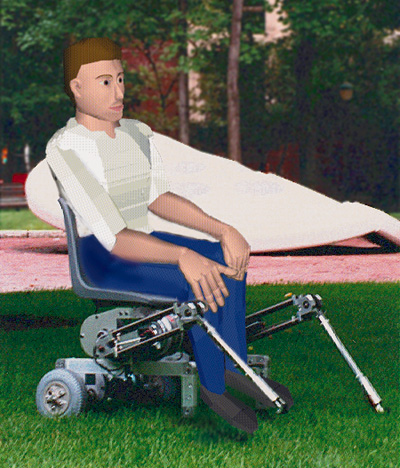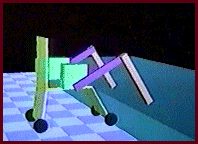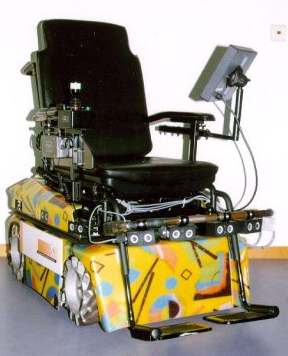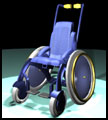Future Direction |
|||
|---|---|---|---|
|
|
|
|
|
|
|
Students Win Award |
Standing Wheelchair |
All Terrain Wheelchair |
ONMI Prototype |
| The future direction of the wheelchair is to produce a chair that is user friendly and empowers the user instead of magnifying his handicap. Independence and dignity are key factors.
Many new types of wheelchairs are being designed for the future. Some are practical and others just visionary. Wearable technology is even being developed. It seems that many of these designs are being created to allow the user to stand or be as tall as a standing person. The increasing of robotic technology allows for new and exciting advances in assistive technology. One major stalling factor for many wheelchair designs is size and bulk. The more robotic you make the wheelchair the more sophisticated equipment it has to have. Compare the first design on this page which is purely visionary to the last desgin on the page which is an actual working prototype and you see the problem. Below are a few innovative ideas that our team found especially interesting. |
|
| Students Win Award for Innovative Wheelchair Design
Seattle students at the Art Institute designed a futuristic wheelchair that becomes part of the person instead of an external tool. The chair features a single gyroscoping wheel and other parts that the users themselves recommended. A quote by Anna Marietta one of the students that designed it said, "The idea is that the wheelchair users would become part of the person instead of just transport." The thinking process started one day in an ordinary classroom. The ahead of time thinkers design got them the 1999 Best Show Award in a national student design competition sponsored by the Austin, Texas-based Association of Professional Model Makers. They put their name down under the category of "Future design." The invention won over eight other countries around the world. The idea was born in a ergonomics class. The group only had four weeks to design the model of the wheelchair. The wheelchair model would only be about 1/4 the size of the real thing. |
 |
Back to the Top |
|
| Standing Wheelchair for Children
Jason Friend has designed a prototype wheelchair for children that keeps the user upright while still wheeling around with free motion. He took an interesting approach while designing his futuristic wheelchair. Jason needed to make his wheelchair simple, safe, comfortable, and non-restricting. He solved this problem by making a wheelchair that is not a chair at all. The goal was to make a child's wheelchair that would alleviate the stigma that is associated with being in a wheelchair. Most children's wheelchairs today are just a small version of an adult wheelchair with no consideration for the special needs and wants of a child. Jason Friend wants to make a chair that will provide for the physical and psychological needs that children have. Standing provides benefits physically for the child: it promotes circulation and body functions; it helps the legs fight against atrophy of the muscles; makes the heart stronger; and helps keep the bones strong. The standing position also lets the child be at eye level with peers. This is a strong psychological benefit. Reaching and getting things is much easier when you are standing. Another consideration was that the chair look interesting to children. A cold sterile chair is not inviting. Jason Friend wanted the new design to spark interest with warm colors, inviting textures, and a 'cool' look. The chair will come in different colors and be adjustable in height. |

Standing Wheelchair Designed for Children, Jason Friend, 1998 |
Back to the Top |
|
| All Terrain Wheelchair - A Hybrid Adaptive Mobility System
"To boldly go where no wheelchair has gone before." One major problem that motorized wheelchairs have is their inability to travel on rough surfaces or over obstacles like steps, rocks or curbs. Some have tried to make the world conform to a standard so people with disabilities wouldn't be so limited in access, but it would be better if the disabled person could go anywhere without needing a pre-existing ramp or access point. What about taking a stroll in a garden or along the beach? That is pretty much impossible for disabled people today. All Terrain Wheelchairs solves this problem by fitting conventional wheelchairs with manipulators or legs. The design is compact, less than 30 inches, to fit through a door and is lightweight for easy operation indoors. Stability is also a strong point. The manipulators are designed to be strong and tip proof providing the needed safety. The prototype is energy efficient and simple in design. The manipulators only work when they are needed while the regular back wheels provide locomotion in most situations. The design proves that the use of manipulators can provide a unique freedom for wheelchair users allowing them to go where ever they want. |

All Terrain Wheelchair Prototype |
|
The philosophy behind the All Terrain Wheelchair is based on developing modular designs. The ATW uses off the shelf components. This makes the manufacturing process easy and affordable. The main advantages of the chair are its versatility, multi functionality, reliability and compact size of the manipulator legs. The designers are applying for a patent on their product and looking for a manufacturer. |
 |
Back to the Top |
|
| The OMNI Wheelchair
The OMNI wheelchair is state of the art with semi-autonomous drive modes, sophisticated navigation, omnidirectional steering, and an array of sensors. Conventional wheelchairs are not suited for crowded rooms, small spaces, or complex structures. The OMNI on the other hand has increased mobility by using omnidirectional driving designs. Sensors (ultrasonic rangefinder and IR) allow obstacle avoidance, computer programs give the ability to follow pre programmed paths (playback movement), and backward tracing lets the driver back up exactly on the path they came in on. Robot technology gives the chair great versatility yet the user can interrupt the process at any time and take control if needed. Safety equipment includes bumpers and sensor rings. The chair also has an anti-tipping mechanism when it is in the elevated position. |

OMNI Wheelchair Prototype |
Back to the Top |
|

